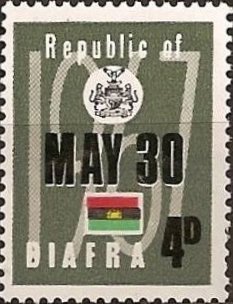Stamp: Flag and coat of arms (Biafra 1968)
Flag and coat of arms (Biafra 1968)
05 February (Biafra ) within release Declaration of independence on May 30, 1967 goes into circulation Stamp Flag and coat of arms face value 4 Biafran penny
| Stamp Flag and coat of arms in catalogues | |
|---|---|
| Michel: | Mi:BIA 2 |
Stamp is square format.
Also in the issue Declaration of independence on May 30, 1967:
- Stamp - Map face value 2;
- Stamp - Flag and coat of arms face value 4;
- Stamp - Mother and child face value 1;
Stamp Flag and coat of arms it reflects the thematic directions:
A flag is a piece of fabric (most often rectangular or quadrilateral) with a distinctive design that is used as a symbol, as a signaling device, or as decoration. The term flag is also used to refer to the graphic design employed, and flags have since evolved into a general tool for rudimentary signalling and identification, especially in environments where communication is similarly challenging (such as the maritime environment where semaphore is used). National flags are patriotic symbols with varied wide-ranging interpretations, often including strong military associations due to their original and ongoing military uses. Flags are also used in messaging, advertising, or for other decorative purposes. The study of flags is known as vexillology, from the Latin word vexillum, meaning flag or banner.
A coat of arms is an heraldic visual design on an escutcheon (i.e. shield), surcoat, or tabard. The coat of arms on an escutcheon forms the central element of the full heraldic achievement which in its whole consists of shield, supporters, crest, and motto. A coat of arms is traditionally unique to an individual person, family (except in the United Kingdom), state, organisation or corporation.


